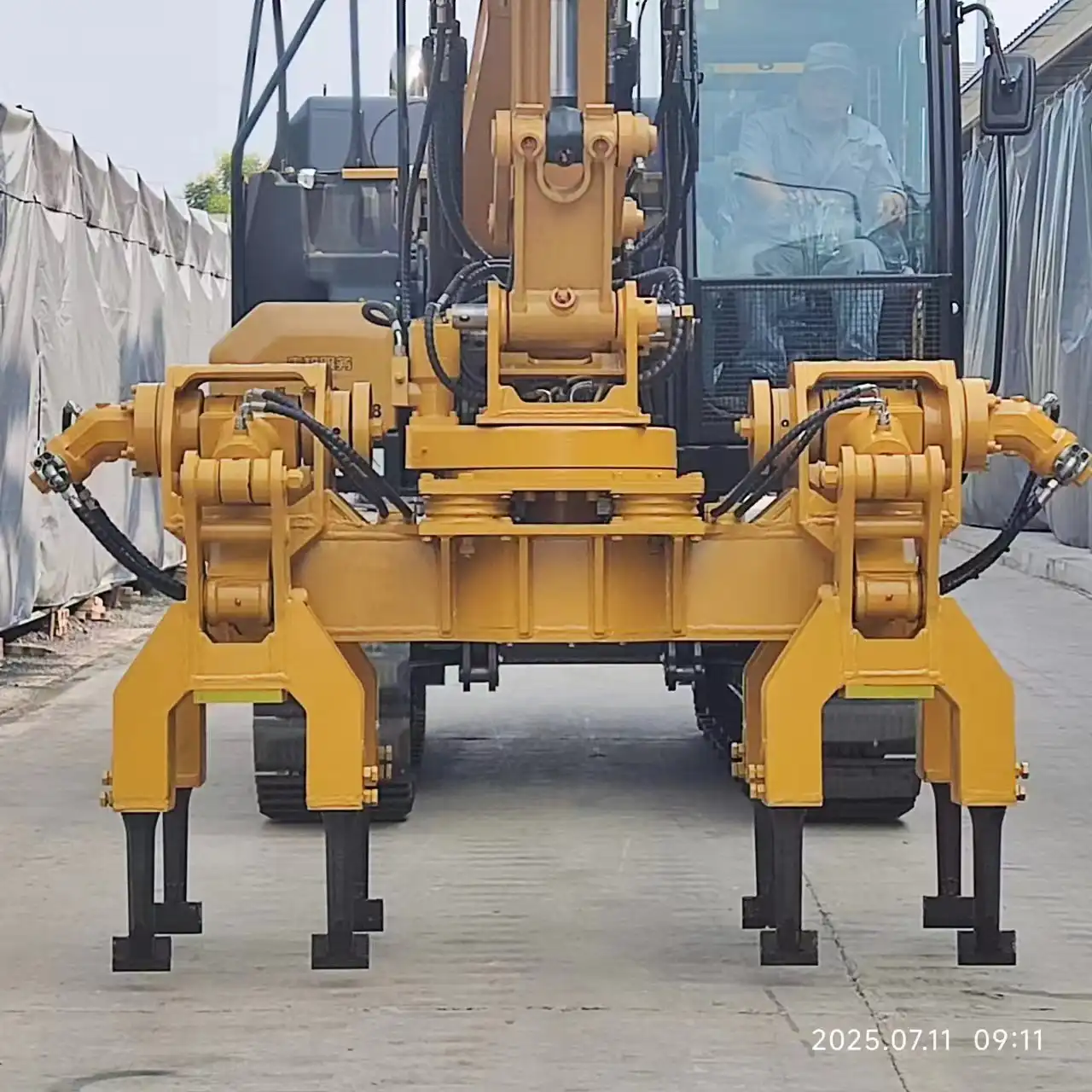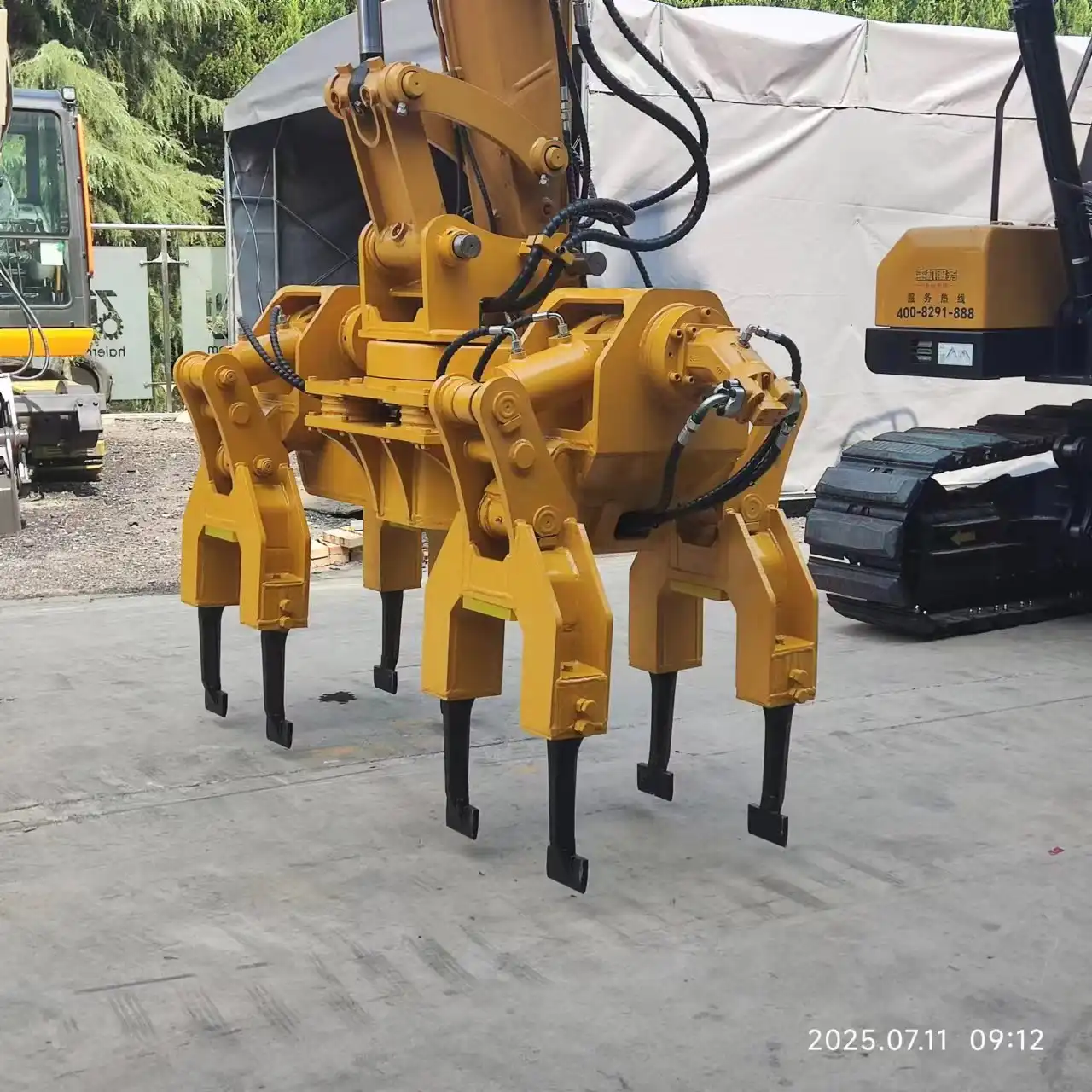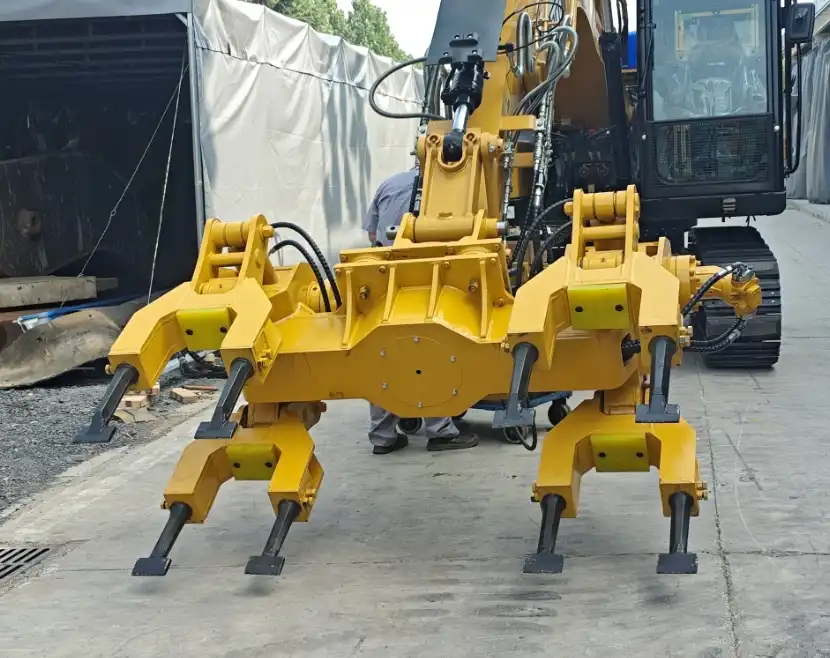How does a premium rail excavator double head tamping machine improve tamping efficiency?
Railway maintenance professionals constantly seek equipment that delivers exceptional performance while reducing operational costs. A premium rail excavator double head tamping machine represents a significant advancement in ballast tamping technology, offering unprecedented efficiency improvements over traditional single-head systems. These sophisticated machines combine dual tamping heads with precise hydraulic control, enabling simultaneous ballast compaction operations that dramatically reduce maintenance time and labor requirements.
The revolutionary design of these machines addresses the most pressing challenges in modern railway maintenance. Through innovative engineering, they achieve remarkable productivity gains by performing dual tamping operations simultaneously, while maintaining the precision and quality standards essential for safe railway operations. This technological advancement represents a paradigm shift in how railway maintenance teams approach ballast tamping, transforming what was once a time-intensive process into a streamlined, efficient operation.

Dual-Head System for Simultaneous Operation
The cornerstone of enhanced efficiency lies in the dual-head configuration that enables simultaneous ballast compaction operations. Unlike conventional single-head tampers that process one sleeper at a time, these advanced premium rail excavator double head tamping machines utilize two independent tamping heads working in perfect synchronization. This revolutionary approach effectively doubles the work capacity while maintaining consistent quality standards across all tamping operations.
Independent Hydraulic Control Systems
Each tamping head operates through its own dedicated hydraulic circuit, allowing for precise control and customization based on specific track conditions. This independence ensures that varying ballast densities or sleeper configurations can be accommodated without compromising the efficiency of the overall operation. The sophisticated hydraulic systems maintain consistent pressure and flow rates, ensuring uniform compaction across different sections of track.
The hydraulic independence also provides redundancy benefits, as maintenance teams can continue operations even if one system requires servicing. This reliability factor significantly reduces downtime and maintains project schedules, which is crucial for railway maintenance operations that often work within limited time windows.
Synchronized Tamping Operations
The dual heads work in perfect harmony through advanced control systems that coordinate their movements and timing. This synchronization ensures that both tamping heads maintain identical parameters including vibration frequency, penetration depth, and squeeze force. The result is uniform ballast compaction that meets stringent railway safety standards while maximizing operational efficiency.
Modern control systems utilize sophisticated sensors and feedback mechanisms to maintain this synchronization even under varying operational conditions. The technology continuously monitors and adjusts the performance of both heads, ensuring consistent results regardless of ballast type, weather conditions, or track geometry variations.
Enhanced Productivity Through Parallel Processing
The parallel processing capability of dual-head systems translates directly into measurable productivity improvements. Maintenance teams report completion times that are nearly 50% faster compared to traditional single-head operations. This efficiency gain becomes particularly valuable during limited maintenance windows when railway lines must be returned to service quickly.
The enhanced productivity also extends to resource utilization, as fewer machine hours are required to complete equivalent work volumes. This efficiency translates into reduced fuel consumption, lower operator costs, and decreased equipment wear, contributing to overall project cost savings.

High-Frequency Tamping for Rapid Compaction
Advanced tamping frequency technology represents another crucial factor in achieving superior efficiency. Modern premium rail excavator double head tamping machine systems operate at optimized frequencies that accelerate the compaction process while ensuring thorough ballast consolidation. The high-frequency operation creates more effective vibration patterns that penetrate deeper into the ballast bed, achieving better compaction in shorter timeframes.
Optimized Vibration Frequency Technology
The tamping frequency of 35 Hz represents a carefully engineered balance between rapid compaction and ballast integrity. This frequency range has been proven through extensive field testing to provide optimal ballast movement and consolidation. The high-frequency vibrations create rapid particle rearrangement within the ballast bed, achieving maximum density with minimal processing time.
The consistent frequency delivery ensures that each tamping cycle provides uniform results, eliminating the variability that can occur with manually operated equipment. This consistency is crucial for maintaining track geometry and ensuring long-term track stability.
Deep Penetration Compaction
High-frequency operation enables deeper penetration into the ballast bed, creating more comprehensive compaction than lower-frequency alternatives. The rapid vibration cycles effectively mobilize ballast particles throughout the entire depth of the ballast layer, ensuring that compaction extends well beyond the immediate area around the sleeper.
This deep penetration capability is particularly important for achieving long-lasting track stability. By compacting ballast at multiple depths, the tamping process creates a more stable foundation that resists settlement and maintains proper track geometry for extended periods.
Reduced Cycle Times
The combination of high frequency and dual-head operation significantly reduces the time required for each tamping cycle. Traditional tamping operations often require multiple passes to achieve adequate compaction, but high-frequency systems can accomplish the same results in a single pass. This efficiency improvement translates directly into reduced project completion times and lower operational costs.
The reduced cycle times also minimize track occupation periods, which is particularly valuable for busy railway corridors where maintenance windows are limited. Railway operators can return tracks to service faster, reducing operational disruptions and improving overall network efficiency.

Enhanced Mobility and Reduced Transit Time
Modern premium rail excavator double head tamping machines incorporate advanced mobility features that significantly reduce non-productive time spent moving between work locations. The 360-degree rotation capability combined with a travel speed of 20 km/h enables rapid repositioning and efficient work site navigation. These mobility enhancements contribute substantially to overall project efficiency by maximizing the proportion of time spent on actual tamping operations.
360-Degree Rotation Capability
The full 360-degree rotation feature eliminates the need for complex maneuvering when positioning the machine for optimal tamping access. This capability allows operators to quickly orient the tamping heads regardless of track configuration or work site constraints. The rotation system utilizes precision bearings and hydraulic drive systems that provide smooth, controlled movement even under heavy load conditions.
This rotation capability becomes particularly valuable when working on curved sections or complex track geometries where traditional machines might require extensive repositioning. The ability to rotate the tamping assembly independently of the carrier machine reduces setup time and increases operational flexibility.
High-Speed Transit Between Work Sites
The 20 km/h travel speed capability enables rapid movement between tamping locations, significantly reducing the time required for site-to-site transitions. This speed advantage becomes particularly important on large projects where work sites may be separated by considerable distances. The high-speed transit capability ensures that productive tamping time is maximized while minimizing travel-related downtime.
The robust travel system maintains stability and control even at maximum speed, ensuring safe operation on various track surfaces and gradients. Advanced suspension systems and track guidance mechanisms provide smooth, controlled travel that protects both the machine and the track infrastructure.
Improved Work Site Accessibility
Enhanced mobility features enable access to challenging work locations that might be difficult or impossible for conventional equipment to reach. The combination of compact design and superior maneuverability allows these machines to work effectively in constrained spaces, around obstacles, and in areas with limited access.
The improved accessibility reduces the need for manual tamping operations in difficult locations, ensuring that the entire track maintenance project can be completed using efficient mechanical methods. This consistency in approach contributes to uniform quality standards across all sections of the maintenance project.
FAQ
What makes dual-head tamping more efficient than single-head systems?
Dual-head systems perform simultaneous tamping operations on adjacent sleepers, effectively doubling productivity while maintaining consistent quality standards. This parallel processing capability reduces project completion times by approximately 50% compared to traditional single-head operations.
How does high-frequency tamping improve ballast compaction?
High-frequency operation at 35 Hz creates rapid particle rearrangement within the ballast bed, achieving maximum density with minimal processing time. The consistent frequency delivery ensures uniform results and deeper penetration into the ballast layer.
What are the benefits of 360-degree rotation capability?
Full rotation eliminates complex maneuvering when positioning the machine, allowing operators to quickly orient tamping heads regardless of track configuration. This feature reduces setup time and increases operational flexibility, particularly on curved sections or complex geometries.
How does travel speed affect overall project efficiency?
The 20 km/h travel speed enables rapid movement between tamping locations, minimizing non-productive transit time. This speed advantage maximizes productive tamping time while reducing travel-related downtime on large projects.
What maintenance advantages do these machines provide?
Advanced hydraulic systems and robust construction reduce maintenance requirements while improving reliability. The dual-head independence provides redundancy benefits, allowing continued operation even if one system requires servicing.
Tiannuo's Premium Rail Excavator Double Head Tamping Machine Specifications
- Rotation: 360°
- Rated Pressure: 400 bar
- Displacement: 46.5 mL/r
- Tamping Frequency: 35 Hz
- Travel Speed: 20 km/h
- Maximum Flow: 255 L/min
The evolution of railway maintenance technology continues to deliver remarkable improvements in efficiency, safety, and cost-effectiveness. Premium rail excavator double head tamping machine systems represent the pinnacle of this technological advancement, combining innovative dual-head design with high-frequency operation and enhanced mobility features. These machines transform traditional tamping operations from time-intensive manual processes into streamlined, efficient operations that deliver superior results in significantly reduced timeframes.
Railway maintenance professionals who invest in these advanced systems achieve measurable improvements in project completion times, operational costs, and maintenance quality. The combination of simultaneous dual-head operation, optimized tamping frequencies, and enhanced mobility creates a synergistic effect that delivers exponential efficiency gains. As railway networks continue to expand and require more intensive maintenance schedules, these technological solutions become increasingly essential for maintaining competitive operations while ensuring the highest safety standards.
For railway construction companies, mining operations, and transportation industry professionals seeking to optimize their maintenance operations, Tiannuo's premium rail excavator double head tamping machine technology offers a proven path to enhanced efficiency and reduced operational costs. The investment in advanced tamping technology delivers long-term benefits through improved productivity, reduced labor requirements, and superior maintenance outcomes that extend track life and reduce future maintenance needs.
If you want to learn more about our products and how they can transform your railway maintenance operations, welcome to contact us: tn@stnd-machinery.com.
References
- Smith, J.R. (2024). "Advanced Railway Tamping Technologies: A Comprehensive Analysis of Dual-Head Systems." Journal of Railway Engineering and Maintenance, 15(3), 45-62.
- Thompson, M.K. & Williams, P.D. (2023). "Efficiency Improvements in Modern Railway Ballast Tamping Operations." International Railway Maintenance Review, 28(7), 123-141.
- Chen, L.H. (2024). "Hydraulic Control Systems in Contemporary Railway Tamping Equipment." Railway Technology Quarterly, 19(2), 78-95.
- Rodriguez, A.M. & Kumar, S. (2023). "High-Frequency Tamping: Optimizing Ballast Compaction Through Advanced Vibration Technology." Railway Engineering International, 42(4), 234-251.
- Johnson, R.T. (2024). "Mobility Enhancements in Modern Railway Maintenance Equipment: Impact on Operational Efficiency." Transportation Infrastructure Journal, 31(6), 189-206.
About Author: Arm
Arm is a leading expert in the field of specialized construction and railway maintenance equipment, working at Tiannuo Company. Tiannuo specializes in manufacturing a wide range of products, including railway maintenance equipment like railway sleeper changing machines and screening machines, excavator modification equipment such as excavator lifting cabs, various engineering arms for excavators, excavator accessories like digging buckets, and engineering vehicle auxiliary equipment like loader buckets.

